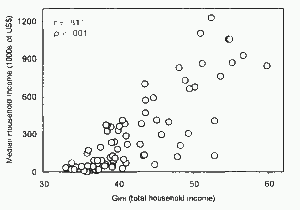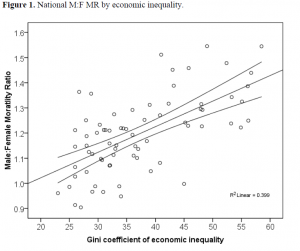Picture an imaginary world where individuals are born into one of two stations in a hierarchy, the Highs and the Lows. While this may sound specific to humans, it is actually a commonplace occurrence, with the alpha position being passed down from mother to daughter and father to son in a variety of group-living species. In this world, the Highs have predominant access to resources, and the Lows are permitted the leftovers. This is the essence of resource (i.e. income) inequality.
Given this arena, let’s zoom in on two Lows. For the purpose of argument, these two individuals are completely equivalent. They are the same size, strength, and overall health, were born in the same position in the hierarchy, and developed similar social and general intelligence levels. There’s just one difference: one of them is aggressive, the other is not.
Who wins? In a setting characterized by want, it becomes valuable to grab whatever is available, and to do so with little concern for others. The non-aggressive individual will only get what is already coming to him, but the aggressive Low will advance his cause. Further, in the special case that the Low gets the drop on a High, that’s a pretty big payday for a guy who is relegated to scraps.
You might ask why this story wouldn’t select for aggression in any environment, regardless of the inequality. Well, I’ve only described the advantages of being aggressive, and one has to keep in mind the costs as well. Aggressiveness is risky. It invites negative physical and social response from others. In many group-living species, individual aggression may meet with collective resistance, meaning picking a fight with one individual can easily become picking a fight with five or ten individuals. Thus, for this risk to be worth it, there needs to be the potential of a real payoff on the other end. In an environment with complete equality, the benefits don’t balance out these risks. If you are simultaneously really close to the bottom and really close to the top, why gamble the former just to get a tiny leg up? This correlation between inequality and aggression has been well-documented by Margo Wilson, Martin Daly and Shawn Vasdev for the neighborhoods of Chicago:
In modern society—and in much of written history—we think of the class structure as multiple stratified worlds. The financial industry and other big rollers are entitled to country clubs, golf courses, yachts and the finest French foods. The middle class gets the lesser luxuries of nice malls, 100 TV channels, comfortable houses in the suburbs, and some discretionary income. The lower class gets Walmart, decrepit houses, and, to boot, some of the least pleasant jobs our society has to offer.
The people in this bottom world are not blind to the other realities, however. With the advent of media, they see it and know of it. They are the Lows who see the Highs, and there’s no clear path to getting there. Thus, the evolved problem solver kicks in: get aggressive. This “solution” is especially prominent in males in the prime of their life, who will take ridiculous risks for the opportunity to gain resources and attract mates. A recent paper by Daniel Kruger (another blogger on this site) has demonstrated that, as uncertainties like inequality mount up, this tendency becomes even more pronounced. Check out the graph below, which demonstrates that, as inequality rises (x-axis, heading to the right), males die at an increasing rate, most likely from taking increased risks.
We like to think that the increased aggression in high-poverty areas is in some way the fault of the people that live there, that depraved people are unsuccessful, and thus the poor are characteristically depraved. There are more complex systems at work, however, and these deleterious behaviors are in fact attempts to compete against all odds, they are adaptive responses to a difficult situation. And this is just one of the things that inequality breeds.


